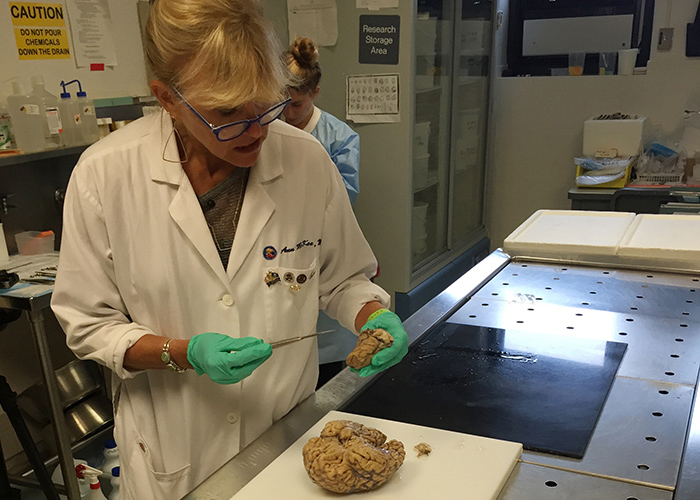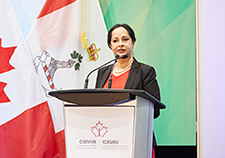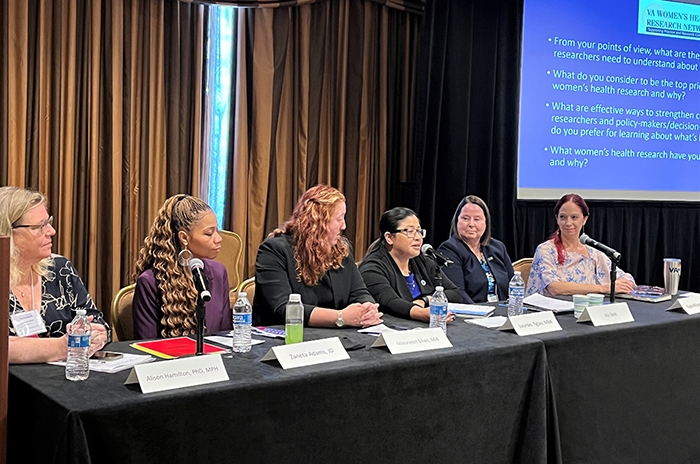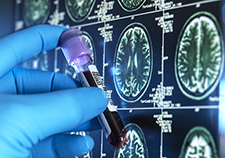Office of Research & Development |
 |


Pathologist Dr. Ann McKee is part of the team behind VA's National PTSD Brain Bank. (Photo courtesy of VA Boston Healthcare System)
October 19, 2017
By Mike Richman
VA Research Communications
Understanding the complex nature of posttraumatic stress disorder, commonly known as PTSD, is one of VA’s most pressing challenges. The agency says substantial percentages of Veterans who fought in Vietnam, the Gulf War, and Iraq and Afghanistan have had that mental health condition sometime in their lives.
PTSD symptoms are well documented: flashbacks, nightmares, hypervigilance, aggressive behavior, and severe anxiety. But pinpointing how the condition affects brain structure and function and prescribing the most effective medications has presented challenges.
Enter VA’s National PTSD Brank Bank (NPBB), a brain tissue biorepository that supports research on the causes, progression, and treatment of PTSD. The bank is responsible for tissue acquisition and preparation, diagnostic assessment, and storage. It’s currently storing tissue from 168 brains, most of which are from people once diagnosed with PTSD. Many of the other donors had major depressive disorder. Other brains are from healthy controls.
"There's a limit to what you can learn from [even] the most sophisticated brain imaging..."
More than 40 of the brains are those of Veterans, about 75 percent of whom had PTSD. Most of the Veterans who donated brains to the bank served in the Gulf War.
The bank is part of a consortium led by VA’s National Center for PTSD at the White River Junction VA Medical Center in Vermont, one of the consortium’s six participating sites. The other sites are the VA medical centers in Boston, the hub site; Miami; Durham, North Carolina; and West Haven, Connecticut, as well as the Uniformed Services University of the Health Sciences in Maryland. Tissue from the bank is sent to those sites as part of NPBB’s intramural research program and is also disseminated to other investigators who conduct research in their own laboratories.

Million Veteran Program director speaks at international forum

2023 VA Women's Health Research Conference

Self-harm is underrecognized in Gulf War Veterans

Head trauma, PTSD may increase genetic variant's impact on Alzheimer's risk
Dr. Matthew Friedman, the former executive director of the National Center for PTSD and now a senior advisor there, established the Brain Bank in 2014. He says it's the only one of its kind: "We are the only PTSD brain bank in the world. None of the other 100-plus brain banks focus on PTSD." The bank’s main purpose, he says, is to advance understanding of the pathophysiology of PTSD–the study of how the disorder affects the brain. He says research on brain tissue from people with PTSD is critical in developing new medications that treat the condition.
“There’s a limit to what you can learn from [even] the most sophisticated brain imaging to understand what’s different about people with PTSD, compared with people with depression or people with Parkinson’s or healthy controls,” Friedman says. “You want to learn what’s different in terms of how they are processing information in key brain areas.”
To do that, Friedman says, there’s no substitute for analyzing brain tissue, for example, to gain a clearer understanding of how the RNA sequencing may differ. RNA, or ribonucleic acid, is a molecule key to the coding, decoding, regulation, and expression of genes. “You also have to look at the part of the gene that is actually activated,” he says. “Different parts of different genes may be active or may be inactive.”
Friedman was the lead author of a status report on the Brain Bank that appeared in August 2017 in Current Psychiatry Reports. The report describes how the bank operates and highlights its accomplishments and its future challenges. One challenge calls for the facility to serve as a “major resource” for brain tissue research of people who had PTSD. To be certain that observed abnormalities are due to PTSD, rather than to some other cause, researchers must compare PTSD brains with tissue from healthy controls and with people who suffered from other psychiatric disorders, with or without PTSD, Friedman says.
Currently, six projects are underway that involve brain bank tissue. Researchers, for example, are looking at brain regions such as the prefrontal cortex, which helps regulate cognitive, emotional, and behavioral functioning, and the amygdala, which affects emotions, survival instincts, and memory. Improper functioning of those regions is linked to symptoms of the disorder.
Of the bank’s two published studies to date, one focused on a gene that has received limited attention in PTSD research: serum and glucocorticoid regulated kinase 1 (SGK1). Looking at postmortem brains from people with PTSD, the researchers found lower levels of the protein that is coded for by the gene. Preclinical tests with rats that lacked the gene and were exposed to stress supported the findings.
Yale University Professor Dr. Ronald Duman, a researcher at the National Center for PTSD, co-authored the 2015 study, which appeared in the journal PLOS Biology.
Friedman says the study found the rats that lacked SGK1 to be much more susceptible to fear conditioning. In this experimental technique, organisms learn to anticipate painful events such as an electric shock when exposed to a non-painful stimulus like a red light. The rats were also much less capable of fear extinction, or learning when the red light is no longer associated with electric shock. “This kind of experiment could not have been done or even conceptualized without looking at brain tissue from patients with PTSD,” he says.
The PTSD bank is one of several VA facilities in Boston that stores brains. The others focus on the study of Alzheimer’s disease; amyotrophic lateral sclerosis, also known as Lou Gehrig’s Disease; Gulf War illness; traumatic brain injury (TBI); and chronic traumatic encephalopathy (CTE), a degenerative brain disease found in those with a history of repetitive brain trauma, such as football players, boxers, and service members exposed to blasts.
All of the Boston-based brain banks are programmatically linked and share staff, labs, and resources.
Friedman says the PTSD bank works most closely with the TBI-CTE brain bank. Such research is clinically relevant because so many Veterans from recent wars suffer simultaneously from PTSD, TBI, and CTE, he says. Future research in collaboration with the Alzheimer’s bank will focus on PTSD in normal aging and in people who develop dementia, he notes.
“Probably one of the most respected neuropathologists in VA is Dr. Ann McKee,” Friedman says. “Ann is the head of the TBI and CTE brain bank, and she’s part of our group, as well. In other words, we’re all part of one group. She might want some of our tissue from the PTSD bank. Likewise, we might want some of the tissue from the TBI bank, or if we’re interested in aging some of the tissue from the Alzheimer’s bank.
“People that work in the PTSD bank also work in some of these other banks,” he adds. “The laboratories, equipment, and infrastructure overlap in many ways. It’s a very, very efficient leveraging of resources.”
For more than a decade, Friedman led efforts to establish a national PTSD brain bank. But a lack of funding and other impediments prevented the project from being launched. Now, with the bank three years old, he says he’s “thrilled that this opportunity has come my way in the latter stages of my career.”
“Hopefully, being able to look at the tissue, being able to approach and understand what’s different about the brain of a person with PTSD, will help us approach this in a novel way and come up with therapeutic approaches,” he says.
The PTSD brain bank acquires brain tissue two different ways. One way is when a person who is alive enrolls in the bank and volunteers to donate his or her brain posthumously. This is called “antemortem tissue.” “Postmortem tissue,” for which consent is obtained from next of kin shortly after death, is obtained through the bank’s network of medical examiner offices and through its collaboration with the Lieber Institute for Brain Development, which works to translate research on schizophrenia and related brain disorders into clinical advances.
Nearly all of the brains at the bank have been received postmortem. But Friedman says there’s an advantage to acquiring tissue from an antemortem donor.
“While the individual is alive, we can ask diagnostic and historical questions,” he says. “We can do blood tests and maybe even brain scans if appropriate. So at the time that they’ve died and have agreed to make their brain available, we have superb data about them. By the way, we’re not just interested in PTSD, because if you have PTSD you have an 80 percent chance of having some other problem. In VA cohorts, the three top diagnoses associated with PTSD are depression, substance use disorders, and TBI.”
To participate in the brain bank, a Veteran doesn’t need to be in VA’s Million Veteran Program (MVP), which enrolls former service members receiving their care in the VA system to study how genes affect health.
However, Friedman says, there’s an advantage to getting a donor from MVP or any other historical data set, such as the National Vietnam Veterans Longitudinal Study or the Vietnam-Era Twin Registry. He says those programs maintain excellent data about the donor, for example, from diagnostic assessments, noting that such information is “much better” than the details in medical records.
Any Veteran or non-Veteran, with or without PTSD, can become a donor to VA’s National PTSD Brank Bank. For more information, call 1-800-762-6609 or visit the bank’s web site: www.research.va.gov/programs/tissue_banking/PTSD/default.cfm.
— Mike Richman
Dr. Matthew Friedman describes the quest to develop new medications that treat PTSD as the “holy grail” of PTSD research. However, the man who founded the PTSD Brain Bank says he and his colleagues have been frustrated by the lack of progress on that front. There has not been a major breakthrough in drug treatment for PTSD in 15 to 20 years, he says.
Most of the medications used to treat PTSD, Friedman explains, are ones that were “originally developed for other purposes and have been dusted off, repurposed for PTSD.” He says those drugs are anti-depressants, anti-adrenergic medications, anti-epileptic mood stabilizers, and some anti-psychotic substances. Some anti-depressants have been the most effective medications so far but haven’t performed as well as cognitive behavioral therapy, a treatment based on changing patterns of thinking or behavior that are behind people’s difficulties and on changing the way they feel, he says.
“There’s much room for improvement,” Friedman says.
The only medication that’s been tested with PTSD in mind has been prazosin, an alpha-1 adrenergic blocking agent that may control nightmares and anxiety. According to Friedman, results with the drug have been mixed, although VA says prazosin has been effective in decreasing nightmares in PTSD patients.
To help in finding more PTSD-specific drugs, Friedman hopes research on the disorder will advance to where investigators will someday be able to identify biomarkers in PTSD patients who are alive. He says that will make it easier for experts to assess risk and vulnerability factors, and to introduce more effective medications and other strategies that would increase resilience.
It would be “wonderful,” he says, if clinicians could apply details from blood and urine samples and cerebrospinal fluid, as well as brain scan imaging techniques, to develop biomarkers that can identify living patients who may be at greater risk of developing PTSD.
Case in point: “If we knew that I was more susceptible than you to a traumatic event,” he says, “and we know that more than half of the American population is going to encounter at least one traumatic event during their lives, then maybe there are some preventative measures that can be taken in advance. It could be a medication or a lifestyle change or some other thing that could make me less vulnerable and more resilient.”
He points to the work of the brain bank on chronic traumatic encephalopathy, which thus far has been diagnosed only posthumously. A major effort is underway there to diagnose CTE in living people through blood tests, CT scans, and MRIs, among other means. Recently, researchers from VA Boston and the Boston University School of Medicine discovered a new biomarker that may allow CTE to be diagnosed during life for the first time.
CTE symptoms are similar to those of Alzheimer’s disease, which at one time could only be diagnosed after death.
“All a surgeon needs is an acute abdomen,” Friedman says. “He cuts it open and finds out whether the problem is the pancreas or a perforated ulcer or something else. We can’t do that yet in psychiatry. Our goal is to be able to find biomarkers for different psychiatric disorders. Many of us in psychiatry and certainly at the National Center for PTSD are trying to identify those biomarkers.”
To Friedman, PTSD poses a unique test.
“PTSD is in my opinion the example par excellence of how environmental events can actually affect brain function and structure,” he says. “It’s that amazing. It’s not about a physical injury as we conventionally understand it. You can get PTSD without any physical injury, and yet the impact of extreme psychological trauma can produce profound changes in the brain that may last for decades or a lifetime.”
— Mike Richman
VA Research Currents archives || Sign up for VA Research updates